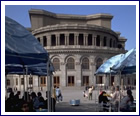 We are sorry to say that Mac is not very well, but he is still
e-mailing strong and recently sent the Beetle a collection of
travel reminiscences about Japan and shopping in Hong Kong.
We are sorry to say that Mac is not very well, but he is still
e-mailing strong and recently sent the Beetle a collection of
travel reminiscences about Japan and shopping in Hong Kong.
When I was first stationed in Japan, the Chaplains would have to counsel Japanese girls that wanted to marry GIs. They would explain to them that they might get homesick in the States so far from their homeland Japan, that customs were different in the States etc etc. One Chaplain told me that the Japanese girl he was counselling got tired of all his little talk and said to him: look here Chaplain, I want to go to the States. I no bullshit you. Ha!
I was stationed in Japan for five and a half years and loved it and it showed in my letters home. I must have gone to Hong Kong from Japan at least a dozen times on our planes. Planes leaving Japan would often stop in Hong Kong no matter what their destination especially at Christmas time. I got to be kind of an unofficial shopper for those that could not leave the base of Japan and this included buying Rosewood furniture for the Commander who was soon to leave for the States. I had to get it on one of our ships returning to Japan and get it thorough customs in Japan. A buddy of mine Nesi met me to act as my interpreter. The customs asked my buddy if I was Important. He told them in Japanese. You dam right he is. He is a Sergeant. (Low Sergeant, however, TSgt.)
We were supposed to be checking weather and intelligence but shopping entered into things. One time I was proudly walking down Nathan Road in Hong Kong in my new Hong Kong shoes when the soles fell off. I bent over to pick them up and my new Hong Kong suit ripped down the back. Chinese thread was not strong and Americans learned in the future to bring American thread to their tailors and hope they would use it.
You got a tailor made suit with two pairs of pants for $25 in 24 hours. Our crew usually stayed in modest hotels, either in the Golden Gate or the Peninsula. They knew our needs, so much so that when sometimes we had to leave early, they would store stuff for us between trips etc. One time, my roommate was a new man in our outfit. We entered our room and three Chinese followed into our room. My buddy said: Mac, who are these folks? I said I don't know. I thought they were with you. They were what we called tailor pimps who tried to get you to go to their tailor shop. They would give you a drink while about three people would be measuring you. You felt like a King. The first time they asked me how I dressed. Are they making conversation? I first put on underwear, then trousers, then shoes. No do you dress left of right? An old timer said to me: Mac they want to know which way your dong hangs to the left or the right so they can arrange material to hide it. I said as far as I know it just hangs and it isn't that big. I have trouble finding it. Ha! The tailor pimps were better informed that our intelligence. They would know our commanders name, when we were arriving in Hong Kong and when we were to leave. One time in a hotel, what we thought was the front desk phoned and said for us to have our luggage out in the hallway by three o clock instead of four. It was a con artist phoning. Our luggage was picked up and there went our Hong Kong suits, souvenirs, military clothing. The works.
AFRH-W Stanley Sagura collects used eye glasses and volunteers to go with a group including eye doctors to distribute them free to needy around the world. I enjoy hearing about his travel experiences. He was with a group of 38 in a tour that were taken to the largest McDonalds in the world in Beijing, China. (Some had gotten tired of eating Chinese food!) This McDonalds had 300 employees. Stanley counted 30 cash registers. They all ordered the same items in advance and were taken to a second floor dining area where they were all fed within five minutes! What service! We were discussing the humorous signs we saw in Japan when the Japanese print signs in English, obviously not their first language.
In Japan they have a drink something like Gatorade they call Sweat. Actually Pocari Sweat. A small bottle of it in a vending machine cost $1.65. They also have a drink called Calpis and a powdered cream like coffee mate called Creep. They have a packaged toothpaste brand of “College” toothpaste in the same colours and layout as the “Colgate” brand. There is a city in Kysushu by the name of Usa that manufactures table service flat ware and had stamped “Made in USA” on it for export until a Japanese agency Ministry of Industry and Trade stopped this. Stanley saw a sign for a detour that read Please Go Sideways and a sign wanting you to put your hand under the faucet that read “Be near your hand when the water flows.”
One sign in a hotel stated “All the water in our hotel has been passed by the Chef.” He saw a sign in a hotel near the manually operated air conditioning that read “When you get hot control yourself.” Control yourself, Mac! Sagara advises that Japanese have difficulty saying “no.” If they disagree they usually say “could you possibly be mistaken?” Or something to that effect. If you ask: is Tokyo in that direction (pointing) and it is actually the wrong direction you may possibly get a “Hai” (yes.) You should ask “Which way is Tokyo?” Answer: that way, (pointing in the right direction.) To open McDonalds in Russia ,where they had difficulty teaching the employees to smile, they first had to open an approved meat processing plant at a cost of US $10m. Now McDonalds are in all major cities in Russia and well patronised.







 The majestic peaks of Mount Ararat provide a stunning
backdrop to Yerevan. The monastery of Khor-Virab and the ruins of
the ancient city of Dvin (dating back to the second century BC) are
located in the mid-distance Aerial view of Yerevan, capital of
Armenia Statue of Komitas, one of Armenia's most loved
composers, outside the Komitas Conservatory. Apart from writing
many original composition, Komitas travelled the country noting
down folk songs for posterity Yerevan, which is nestled in the
shadow of the snow-capped heights of the majestic mount Ararat,
where the Biblical Noah's Ark first landed escaping the Great
Flood, is the capital city of Armenia. With a population numbering
over 1.2 million, Yerevan is a bustling city. The central plaza,
Republic Square, is designed in the Armenian national style and
houses the Government House, the Cabinet and other governmental
offices as well as the Erebuni and Armenia hotels.
The majestic peaks of Mount Ararat provide a stunning
backdrop to Yerevan. The monastery of Khor-Virab and the ruins of
the ancient city of Dvin (dating back to the second century BC) are
located in the mid-distance Aerial view of Yerevan, capital of
Armenia Statue of Komitas, one of Armenia's most loved
composers, outside the Komitas Conservatory. Apart from writing
many original composition, Komitas travelled the country noting
down folk songs for posterity Yerevan, which is nestled in the
shadow of the snow-capped heights of the majestic mount Ararat,
where the Biblical Noah's Ark first landed escaping the Great
Flood, is the capital city of Armenia. With a population numbering
over 1.2 million, Yerevan is a bustling city. The central plaza,
Republic Square, is designed in the Armenian national style and
houses the Government House, the Cabinet and other governmental
offices as well as the Erebuni and Armenia hotels.
 Yerevan, the ancient capital of Armenia, extends you a
warm and friendly welcome. It is one of the oldest cities in the
world. The earliest recorded settlement there dates back to 782 BC.
King Argishty I founded a fortress city in the north-eastern part
of present-day Yerevan, with the following cuneiform inscription,
“With the majesty of God Khald, Argishty, son of Menua, built
up this inaccessible castle and named it Erebuni…” You can
still see relics from this part of our history at the Erebuni
Museum in Yerevan.
Yerevan, the ancient capital of Armenia, extends you a
warm and friendly welcome. It is one of the oldest cities in the
world. The earliest recorded settlement there dates back to 782 BC.
King Argishty I founded a fortress city in the north-eastern part
of present-day Yerevan, with the following cuneiform inscription,
“With the majesty of God Khald, Argishty, son of Menua, built
up this inaccessible castle and named it Erebuni…” You can
still see relics from this part of our history at the Erebuni
Museum in Yerevan.
 As you explore the many interesting sights in Yerevan, you will
learn about the culture and history of one of the world's
oldest nations.
As you explore the many interesting sights in Yerevan, you will
learn about the culture and history of one of the world's
oldest nations.